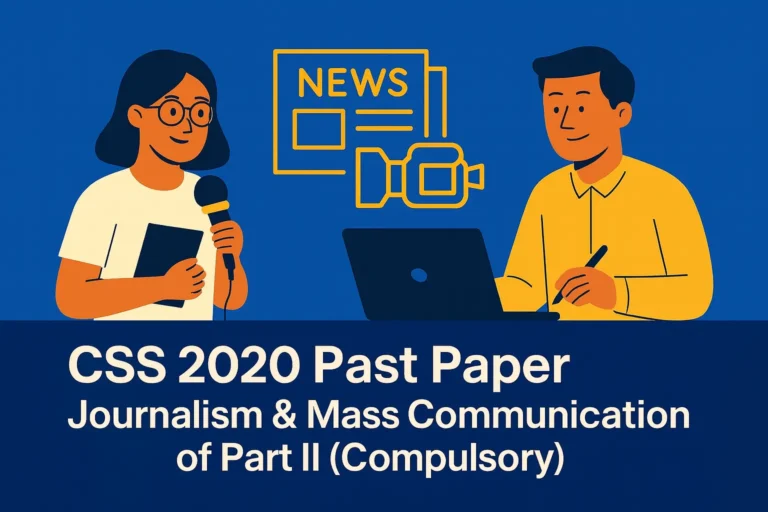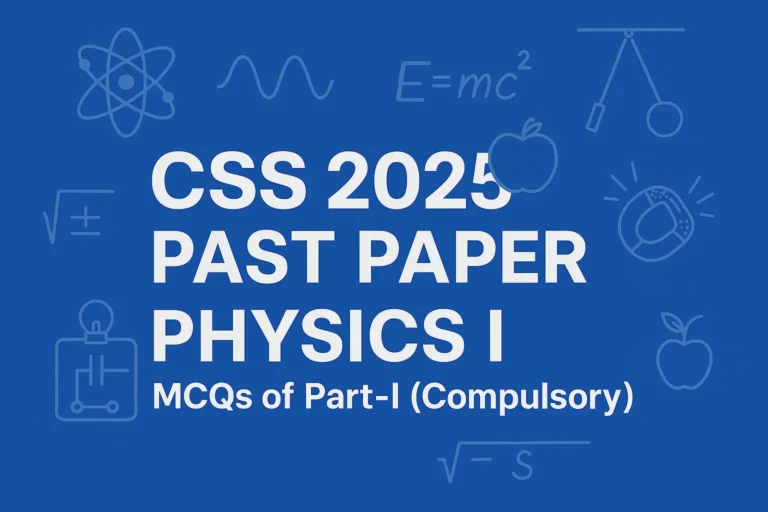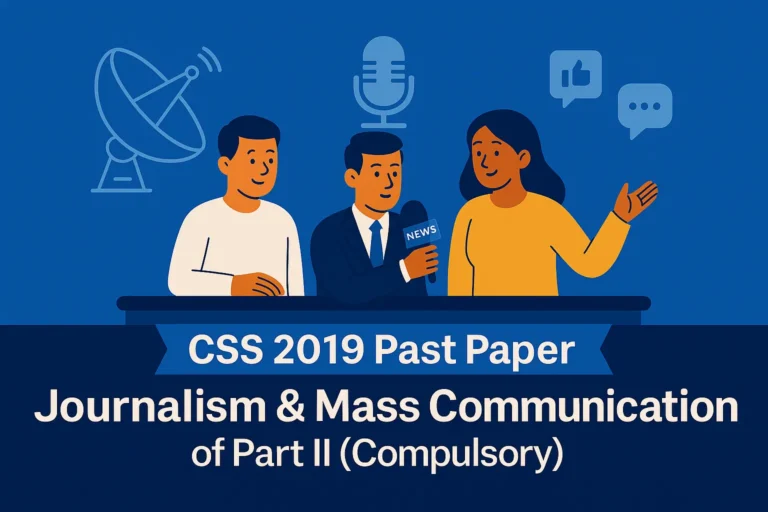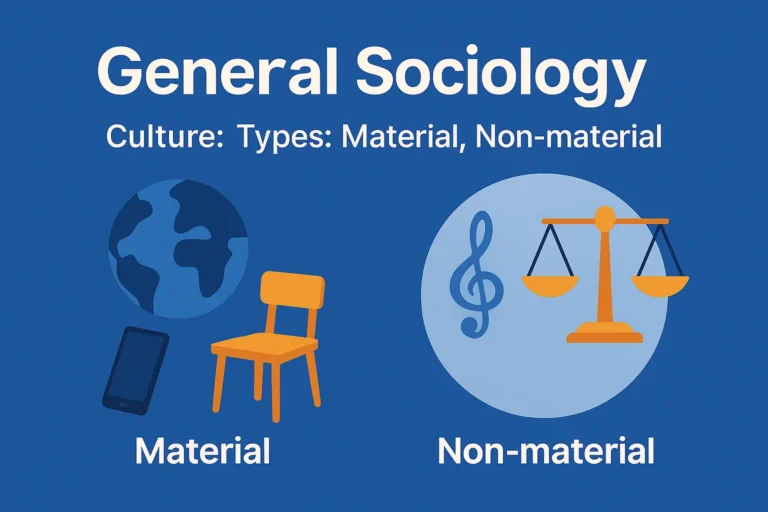CSS 2017 Solved Past Paper – Pakistan Affairs Part-II (Compulsory)
Below is the solution to PART-II (COMPULSORY) of the CSS 2017 Pakistan Affairs Paper.
Question 2
Pakistan’s national culture reflects unity in diversity. Elaborate.
Introduction
Pakistan’s national culture beautifully blends various regional, ethnic, and linguistic traditions into a vibrant tapestry. It stands as a living testament to the idea of “unity in diversity”, where a strong national identity coexists with and is enriched by the distinct cultural expressions of its people. This synthesis forms a cohesive and integrated national ethos.
I. The Foundations of Unity
Several powerful forces bind the nation together:
- Religion (Islam): Islam serves as the strongest unifying factor. The very foundation of Pakistan was laid on the aspiration of South Asian Muslims to live according to their faith. Shared religious practices, Eid celebrations, Ramadan, and prayers in Arabic, foster a sense of brotherhood (Ummah) that transcends ethnic and provincial boundaries.
- National Symbols: The national flag, anthem, Urdu language, and emblem inspire patriotism and a shared identity among all Pakistanis, regardless of their background.
- Common History and Struggle: The collective memory of the Pakistan Movement, the leadership of Quaid-e-Azam Muhammad Ali Jinnah, and the sacrifices made for independence form a unifying historical narrative.
- Love for the Motherland: A deep emotional attachment to Pakistan’s geography, its rivers, mountains, and cities, creates a shared sense of pride and ownership.
II. The Manifestations of Diversity
Pakistan’s unity is enriched by its internal diversity:
- Linguistic Diversity: While Urdu is the national language, numerous regional languages flourish:
- Punjabi: Known for its folk music (Bhangra) and poetry (e.g., Waris Shah).
- Sindhi: Rich in Sufi traditions and ancient history linked to the Indus Valley Civilization.
- Pashto: Celebrated for its poetry (e.g., Rahman Baba) and code of honor (Pashtunwali).
- Balochi: Reflects the nomadic and brave spirit of Balochistan.
- Saraiki, Hindko, Kashmiri, and others add further depth to the linguistic landscape.
- Ethnic and Cultural Diversity: Each major ethnic group, Punjabis, Sindhis, Pashtuns, Baloch, Muhajirs, Kashmiris, has distinct customs, attire, and cuisine:
- Dress: From the versatile shalwar kameez to the Pashtun Pakol and Balochi embroidered garments.
- Cuisine: Varied flavors include Punjab’s meat-rich dishes (e.g., Nihari), Sindhi spicy biryani, Pashtun Chapli Kebabs, and coastal seafood.
- Festivals and Music: Beyond religious festivals, regional events like Basant (in Punjab), Jashn-e-Shikarpur, Urs of Sufi saints, and Sibi Mela are celebrated with enthusiasm. Music ranges from Qawwali and Sufi melodies to Attan and folk traditions.
III. The Synergy: How Diversity Strengthens Unity
Pakistan’s diversity is a source of strength:
- Cultural Exchange: Interactions among cultures have created a composite national identity, evident in music, art, and daily life.
- National Resilience: Each region contributes uniquely, Punjab’s agriculture, Sindh’s ports, Balochistan’s resources, KPK’s strategic location, enhancing the nation’s overall strength.
- A Rich Heritage: This diversity makes Pakistan’s cultural heritage incredibly multifaceted and attractive.
Conclusion
Pakistan’s national culture is a magnificent mosaic. The unifying threads of Islam, history, and national symbols provide the framework, while diverse traditions add color and intricacy. This harmonious blend, unity in diversity, forms the essence of Pakistani identity, making it resilient and profoundly rich.
Question 3
Discuss the role of judiciary in the constitutional development of Pakistan.
Introduction
The judiciary in Pakistan has played a pivotal, complex, and often controversial role in the nation’s constitutional development. Its journey reflects a constant struggle to assert independence, interpret a frequently disrupted constitution, and mediate among powerful state institutions.
I. The Early Years: Validation of Abrogation (1958–1969)
In the initial decades, the superior judiciary often legitimized military coups:
- The Dosso Case (1958): Following Ayub Khan’s coup, the Supreme Court validated the military takeover under the “Doctrine of Necessity”, setting a dangerous precedent for judicial approval of extra-constitutional acts.
- Role under the 1962 Constitution: The judiciary operated under a framework it had indirectly sanctioned.
II. A Shift Toward Constitutionalism: The Asma Jilani Case (1972)
A significant turning point emerged after the fall of East Pakistan:
- Asma Jilani Case (1972): The Supreme Court, under Chief Justice Hamoodur Rahman, overruled the Dosso judgment, declaring Yahya Khan’s martial law illegal and emphasizing the need for constitutional supremacy.
III. The Zia-ul-Haq Era: Between Validation and Resistance (1977–1988)
The judiciary faced severe tests during Zia’s rule:
- Nusrat Bhutto Case (1977): The Court again invoked the “Doctrine of Necessity” to validate Zia’s coup.
- Eighth Amendment: The judiciary interpreted powers that allowed the president to dissolve the National Assembly, leading to political instability.
- Foundations of Judicial Activism: Despite compromises, the courts began expanding fundamental rights and checking executive excesses.
IV. The Era of Judicial Activism and the Lawyers’ Movement (1999–2009)
This period marked the judiciary’s transformation into a proactive institution:
- Zafar Ali Shah Case (2000): The Supreme Court initially validated Musharraf’s coup but set a timeline for a return to democracy.
- Lawyers’ Movement (2007–2009): Musharraf’s suspension of Chief Justice Iftikhar Muhammad Chaudhry triggered a mass movement that restored the judiciary’s independence.
- Suo Motu Actions: The post-restoration court actively intervened in issues like missing persons, corruption, and governance.
V. The Current Role: Guardian of the Constitution (2010–Present)
The judiciary has firmly established itself as a key state pillar:
- 18th Amendment: The Court played a crucial role in interpreting this landmark reform, which strengthened parliament and federalism.
- Disqualification of Prime Ministers: The Supreme Court held high office accountable, disqualifying Prime Ministers Yusuf Raza Gilani (2012) and Nawaz Sharif (2017).
- Arbiter of Federal Disputes: The judiciary frequently resolves conflicts between the federation and provinces, reinforcing federalism.
Conclusion
The judiciary’s role has evolved from legitimizing coups to defending constitutionalism. Despite controversies, it has increasingly upheld the rule of law, fundamental rights, and institutional accountability, becoming a cornerstone of Pakistan’s democratic system.
Question 4
CPEC is a flagship project of One Belt One Road (OBOR) and a regional game changer. Explain.
Introduction
The China-Pakistan Economic Corridor (CPEC) is the flagship project of China’s Belt and Road Initiative (BRI). It is a comprehensive framework of bilateral agreements aimed at enhancing economic cooperation and connectivity between Pakistan and China, with transformative potential for the region.
I. CPEC as the Flagship of BRI/OBOR
CPEC holds a privileged position within BRI due to:
- Strategic Location: Pakistan provides the shortest route for China to access the Arabian Sea, reducing dependence on the vulnerable Malacca Strait.
- Deep Strategic Trust: The “all-weather” partnership between China and Pakistan ensures smooth implementation.
- Early Harvest Success: CPEC’s rapid progress in its initial phases makes it a showcase project for BRI.
II. How CPEC is a “Game Changer”
Economic Transformation:
- Energy Sector: CPEC added over 10,000 MW of electricity to the national grid, alleviating chronic power shortages.
- Infrastructure Development: Modern motorways, railways, and fiber-optic networks enhance connectivity and reduce logistics costs.
- Industrial Cooperation: The goals of Special Economic Zones (SEZs) are to increase exports, generate employment, and draw in manufacturing investment.
- Gwadar Port: Pakistan will become a regional trading hub thanks to this deep-sea port, which will bring in a sizable sum of money.
Geostrategic Impact:
- For China: CPEC expands China’s influence into the Indian Ocean by offering a safe overland trade and energy corridor.
- For Pakistan: It increases Pakistan’s strategic significance, lessens its reliance on the West, and incorporates it into international trade networks.
- Regional Integration: Through its potential to link China with Central Asia, Afghanistan, and Iran, CPEC could promote economic interdependence.
III. Challenges and the Way Forward
- Security Concerns: It is crucial to guarantee the security of Chinese projects and labourers.
- Debt Sustainability: It takes careful financial planning to manage repayment obligations.
- Political Consensus: It is essential to guarantee consistent political support and fair benefits for all provinces.
Conclusion
With the potential to change Pakistan’s economy and position in the region, CPEC is a game-changing project. It has the potential to be a real game-changer for Pakistan and the wider region if it is handled openly and inclusively.
Question 5
Explore the significance of Shanghai Cooperation Organization (SCO) for Pakistan.
Introduction
An important turning point in Pakistan’s foreign policy was its admission as a full member of the Shanghai Cooperation Organisation (SCO) in 2017. Pakistan benefits strategically, economically, and diplomatically from membership in the SCO, a significant Eurasian political, economic, and security block.
I. Strategic and Security Significance
- Counter-Terrorism Cooperation: For Pakistan, the SCO offers a forum for intelligence exchange, cooperative training, and the fight against terrorism, extremism, and separatism.
- Managing Rivalry with India: To ease tensions and promote collaboration on matters such as Afghanistan, the SCO provides India with a structured multilateral forum for discussion.
- Strengthening Ties with China: Pakistan’s strategic alignment with China is strengthened through active participation in the SCO.
II. Economic and Connectivity Significance
- Integration with Central Asia: Because of its location, Pakistan can use the ports of Gwadar and Karachi to act as a trade and energy corridor for landlocked Central Asian Republics (CARs).
- Access to New Markets: Opportunities for trade, investment, and energy partnerships are presented by SCO’s sizable market.
- Infrastructure Development: Pakistan can draw in investment for CPEC-related projects.
III. Diplomatic and Political Significance
- Multilateral Engagement: Pakistan’s diplomatic standing and integration into Eurasian affairs are enhanced by full membership.
- Balancing Foreign Policy: Through the SCO, Pakistan can expand its alliances beyond its conventional allies and establish closer ties with Russia and Central Asia.
- Influence on Afghanistan: Pakistan can strengthen its diplomatic standing by supporting regional initiatives for Afghan stability.
Conclusion
Pakistan’s membership in the SCO is a strategic advantage. By strengthening diplomatic clout, economic integration, and regional security, it establishes Pakistan as a major actor in Eurasia.
Question 6
Enumerate the measures adopted by HEC for promotion of higher education and qualitative research in Pakistan.
Introduction
With a comprehensive plan to improve quality, relevance, and accessibility, the Higher Education Commission (HEC), which was founded in 2002, completely transformed Pakistan’s higher education system.
I. Quality Assurance and Accreditation
- Quality Assurance Agency (QAA): Maintains standards through institutional reviews and programme accreditation.
- National Qualifications Framework (NQF): Outlines degree-specific learning objectives, guaranteeing uniformity and cross-border compatibility.
- Curriculum Revision: Outdated curricula were updated to reflect current market demands and knowledge.
II. Promoting Research and Development (R&D)
- Research Grants Program: Research projects across disciplines are funded by competitive, merit-based grants (e.g., NRPU).
- Digital Library Access: Provides free access to millions of research articles and journals.
- HEC Recognized Journals: A system to recognize and rank journals encourages quality publications.
- Patent Filing Support: Programs help researchers file patents and commercialize innovations.
III. Faculty and Student Development
- Foreign Scholarship Program: Over 10,000 scholars were sent abroad for PhD studies.
- Indigenous Scholarship Program: Supports MS and PhD studies within Pakistan.
- Faculty Development Programs: Training in pedagogy, research methodology, and IT skills.
- Tenure Track System (TTS): Performance-based appointments reward teaching and research excellence.
IV. Infrastructure and Technology Enhancement
- Video Conferencing Facilities: Connect universities with international experts.
- High-Speed Internet: Upgraded IT infrastructure supports research and learning.
V. Promoting Equity and Access
- Need-Based Scholarships: Support financially disadvantaged students.
- Development of Universities in Rural Areas: New campuses and universities in less-developed regions decentralize quality education.
Conclusion
HEC’s reforms have dramatically improved enrollment, faculty quality, and research output. Despite challenges, it remains central to Pakistan’s educational development.
Question 7
Explore the option of alternative energy resources to overcome energy crisis in Pakistan.
Introduction
Pakistan’s energy crisis, characterized by severe electricity shortages, reliance on imported fossil fuels, and circular debt, requires a strategic shift toward indigenous alternative and renewable energy (ARE) resources for sustainability and security.
I. Solar Energy
- Potential: Pakistan has high solar irradiance, especially in Balochistan, Sindh, and Punjab.
- Options: Utility-scale solar parks (e.g., Quaid-e-Azam Solar Park) and rooftop solar systems with net-metering.
- Advantages: Abundant, free fuel source, rapid deployment, and silent operation.
II. Wind Energy
- Potential: A 60 GW wind corridor exists in coastal Sindh and Balochistan.
- Options: Wind power farms through public-private partnerships.
- Advantages: Mature technology, cost-competitive, and utilizes barren land.
III. Hydropower (Large and Small-Scale)
- Potential: Over 60 GW of untapped potential.
- Options: Large dams (e.g., Diamer-Bhasha) and small/micro-hydro projects in northern areas.
- Advantages: Cheapest source of electricity, provides water storage, and has long plant life.
IV. Biomass and Waste-to-Energy
- Potential: Abundant agricultural waste (e.g., bagasse, rice husk) and municipal solid waste.
- Options: Plants for incineration, gasification, or biogas production.
- Advantages: Dual benefit of waste disposal and energy generation.
V. Challenges and the Way Forward
- High Initial Investment: Attract foreign and local investment through clear policies.
- Grid Infrastructure: Modernize the grid to handle intermittent renewable sources.
- Policy Consistency: Ensure long-term tariffs and guarantees to incentivize investment.
Conclusion
A diversified energy portfolio based on renewables can overcome Pakistan’s energy crisis, reduce imports, enhance energy security, and support sustainable development.
Question 8
How general elections in 2002, 2008 and 2013 strengthened democracy in Pakistan?
Introduction
The general elections of 2002, 2008, and 2013 represent a critical sequence in Pakistan’s democratic evolution. Each election, held after periods of military rule, strengthened democratic norms, processes, and institutions.
I. The 2002 Elections: Transition from Direct Military Rule
- Return of Civilian Government: Ended three years of direct military rule under Musharraf, though under the shadow of the Legal Framework Order (LFO).
- Mainstreaming of Religious Parties: The Muttahida Majlis-e-Amal (MMA) gained significant influence, demonstrating the electoral process’s inclusivity.
- A Democratic Façade, but a Process Begun: Initiated a limited return to parliamentary governance.
II. The 2008 Elections: A Watershed for Democratic Resistance
- Backlash Against Musharraf: Voters rejected Musharraf’s supported party (PML-Q), especially after his unconstitutional actions in 2007.
- Peaceful Transfer of Power: The first transition from one civilian government to another through elections.
- Charter of Democracy (COD): Signed by PPP and PML-N, committing to democratic norms and rejecting military intervention.
III. The 2013 Elections: The First Civilian-to-Civilian Transition
- Historic Milestone: The first time a civilian government completed its term and transferred power through elections.
- Emergence of a Third Force: Pakistan Tehreek-e-Insaf (PTI) emerged as a significant political force, reflecting a more competitive political environment.
- Strengthened Election Commission: The Election Commission of Pakistan (ECP) conducted the elections with enhanced credibility.
Cumulative Strengthening of Democracy
- Normalization of Electoral Cycles: The idea of a five-year electoral cycle gained acceptance.
- Strengthened Political Parties: Parties learned to campaign, govern, and function within the system.
- Voter Awareness: Public participation and awareness increased significantly.
- Media and Civil Society: Played a crucial role in scrutinizing elections and holding governments accountable.
Conclusion
Despite challenges, these elections reinforced democratic institutions, established peaceful transitions, and fostered a culture of accountability, strengthening Pakistan’s democracy.






